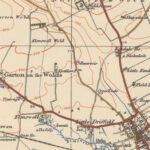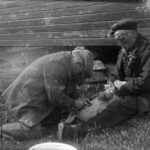11 November 1641: At Martinmas, Henry Best starts cutting willow at Elmswell (Driffield) to make farm implements
Henry Best. 1857. Rural Economy in Yorkshire, in 1641. Ed. Charles Best Robinson. Durham: Surtees Society. Get it:
.Excerpt
At Martinmas, or about a week after Martinmas, we set our foreman to cutting of white-wilfes, red-wilfes, and saughs [sallows, i.e. willows], for heck-stowers [fodder rack spars] and harrow-spindles [crosspieces]. He is to have charge given to cut them as near to the ground and bodies of the trees as possibly he can: and then, afore he cut off the twigs, to see what the branch is fittest for, and to make that of every bough and branch that it is most fit for. Some will be for flail handstaffs; some that have creches [hooks?] will be for rake shafts; some for heck-stowers; and the smallest sort of them for harrow-spindles; some for cradle-teeth; and some short ones for plough staffs. He has for this purpose a little broad snathing [pruning] axe, whereof he is to have an especial care, that he cut not against stones or iron. For an axe will last some seven years as well as others a year, for if they heed not, but chop against stone or iron, then is her edge turned again, and then must she to the grindstone; and that takes away and wastes her best metal. The course that we take with our white-wilfes and saughs is to cut them up by the roots, or as close to the ground as possibly we can, if we can but preserve them from being eaten with cattle: by this means have we great increase of them; for out of the roots will grow many young trees, which, in four or five years space, will come to that perfection and bigness, that they will serve for flail-hand-staffs, caving-rake-shafts, heck-stowers, and such other like uses and in Essex, by cutting up of saughs by the roots, they will grow up again to that height and tallness that they serve them for hop-poles; and then, when they come to cut them the second time, they cut them within two or three inches, or as close to the old stump as possibly they can, and that causes them to put out thicker still.
Comment
Comment
I think the red willow is Salix x rubra – red osier – rather than fragilis.
Something to say? Get in touch
Original
FOR PROVIDINGE OF HECKE-STOWERS AND HARROWE-SPINDLES.
Att Martynmasse, or aboute a weeke after Martynmasse, wee sette our foreman to cuttinge of white-wilfes, reade-wilfes, and saughs, for hecke-stowers and harrowe-spindles; hee is to have charge given to cutte them as neare to the grownd and bodyes of the trees as possibly hee can: and then, afore hee cutte of the twigges, to see what the branch is fittest for, and to make that of everie bough and branch that it is most fitte for: some will be for flayle-handstaffes; some that have creches will bee for rake-shaftes; some for hecke-stowers; and the smallest sort of them for harrowe-spindles; some for cradleteeth; and some shorte ones for plough-staffes. Hee hayth for this purpose a little broad snathinge axe, wheareof hee is to have an especiall care, that hee cutte not against stones or yron; for an axe will last some seaven yeares as well as others a yeare; for if they heede not, but choppe against stone or yron, then is her edge turned againe, and then must shee to the grindstone; and that taketh away and wasteth her best mettle. The course that wee take with our white-wilfes and saughs is to cutte them up by the rootes, or as close to the grownde as possibly wee can, if wee can but preserve them from being eaten with cattle: by this meanes have wee greate increase of them; for out of the rootes will growe many younge trees, which, in fower or five yeares space, will come to that perfecktion and bignesse, that they will serve for flayle-hande-staffes, cavingerake-shaftes, heckestowers, and such other like uses and in Essex, by cuttinge up of saughs by the rootes, they will growe up againe to that height and tallnesse that they serve them for hoppe-poles; and then, when they come to cutte them the second time, they cutte them within two or three ynches, or as close to the olde stumpe as possibly they can, and that causeth them to putte out thicker still. For plantinge of these trees, you neede doe noe more but take a branch of a willowe or saugh-tree, and sticke it into the grownde, and it will take presently; especially if it bee neare the water-side; for take wilfes, and lye parte of them in a runninge water and parte of them out, and, if it bee in the spring-time, they will budde as they lye. As for reade-wilfes, the course that wee take with them, to have profitte of them in a shorte space, is to take longe branches aboute fower yards in length, and to thrust them into the grownde aboute halfe a yard within the grownde; and this should bee aboute the beginninge of March; and afore yow sette it, yow are to snath of all the small twigges and boughes, leavinge onely the toppe-bough to drawe up the sappe; and yow are to take such course as nothinge may rubbe against it, and loosen it at the roote, till such time as it have gotten good roote hold; and then, if it live and budde forth, yow may lette it alone till that time of the yeare come againe, and then are yow to dresse of all the twigges againe, and to cutte of the toppe allsoe, aboute eight foote or three yards from the grownde; or, howesoever, leave it of that height that cattle may not reach to the toppe of it to eate of the buddes as it putteth forth, and yow shall see that it will putte forth many boughes and branches, rounde aboute the place wheare you cutte of the toppe and when these branches come to that bignesse that yow intende to cutte them againe, yow are to cutte them as neare to the olde head, or place wheare yow cutte it afore, as possibly yow can; and this is called headinge of wilfes; and if, in headinge them, yow chance to nicke them or cutte them over neare the olde heade, soe that the barke growe up above the stumpe rownde aboute, soe that the raine and wette stande and sattle into the hollownesse thereof, it will bee the decay of the whole tree, or att least of the part that is soe cutte. The first decay of wilfes is allwayes att the hearte, for they will rotte, mosker, and bee hollowe within, soe that a man may stande within them, when the sides are sounde and the tree alive.
755 words.
Similar
 22 November 1641: Snow falls at Elmswell (Driffield), and sheep farmers jostle for low ground and feed
22 November 1641: Snow falls at Elmswell (Driffield), and sheep farmers jostle for low ground and feed 6 June 1641: Under a waning gibbous moon, armed with a penknife and sticky-willy unguent, a shepherd castrates Henry Best’s lambs at Elmswell (Driffield)
6 June 1641: Under a waning gibbous moon, armed with a penknife and sticky-willy unguent, a shepherd castrates Henry Best’s lambs at Elmswell (Driffield)Search
Donate
Music & books
Place-People-Play: Childcare (and the Kazookestra) on the Headingley/Weetwood borders next to Meanwood Park.
Music from and about Yorkshire by Leeds's Singing Organ-Grinder.


 Bluesky
Bluesky Extwitter
Extwitter